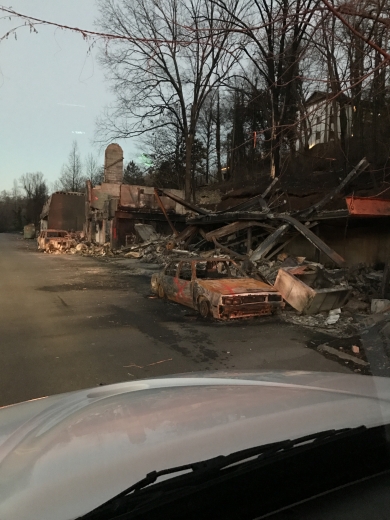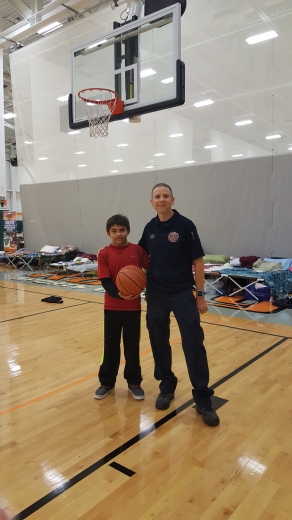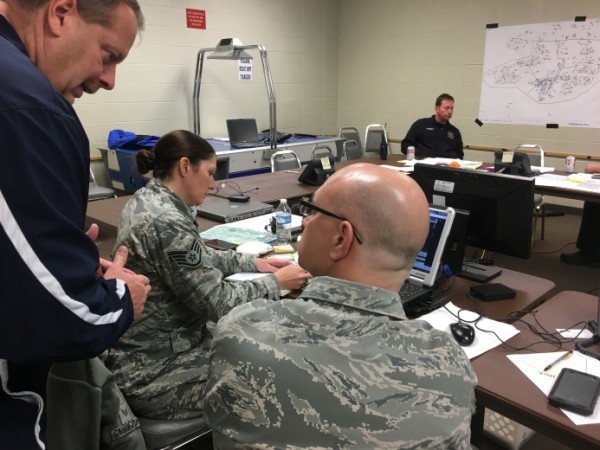
Oak Ridge National Laboratory Fire Department Chief Officers Daron Long, Larry Lewis, and Danny Parker (in navy polo shirts) are pictured above in the Incident Command Center. (Photo by ORNL)
By U.S. Department of Energy
The Great Smoky Mountains, which are normally wet and hazy, had been in a particularly prolonged drought when a fire started near a popular lookout several miles from the resort town of Gatlinburg, Tennessee, just before Thanksgiving. Park officials warily watched the slowly spreading blaze, which was in nearly vertical and mostly unreachable terrain.
At the close of the holiday weekend, a weather system moved in, whipping up gale-force winds hours ahead of the rain. The wind supercharged the fire, driving eerie, thick smoke down the basin toward the town. By Monday night, the homes, resorts, and businesses surrounding Gatlinburg were in the middle of a firestorm as flames destroyed structure after structure. Downed power lines sparked separate fires.
On the evening of November 28, park and city officials reached out to firefighters in the region for support as flames engulfed entire neighborhoods. By the time quenching rains arrived, the 17,000-acre forest fire had burned 1,700 structures—many of them homes—and took 14 lives.
Firefighters from Oak Ridge National Laboratory, located about 50 miles away, were among those who answered the call. With an immediate go-ahead from the ORNL Site Office, the ORNL Fire Department, or ORNLFD, dispatched resources to assist responders in Gatlinburg and neighboring Pigeon Forge.
ORNLFD officers reported within hours to relieve exhausted emergency responders on the evening of November 28. The ORNL team went to work strengthening the incident command organizational structure and dividing the city into four geographical divisions to help manage the scores of responders who poured in from across the state. Guided by extensive FEMA (Federal Emergency Management Agency) Incident Command System training, they made several strategic decisions that included coordinating helicopter water drops.
ORNLFD members who supported the Gatlinburg incident command post were Larry Lewis, Danny Parker, Daron Long, and Mike Masters, plus Dennis Brock of the Office of Technical Training Delivery. ORNLFD Battalion Chief Tony Bloyd was called in to set up communications systems for the emergency, and the laboratory shift superintendent, or LSS, Emergency Management Team’s Daron Keesee was sent via the National Guard in Nashville.
When state officials requested an ambulance through its mutual aid system, ORNL sent a unit that was staffed by a rotating crew of eight. It supported field operations during the early days after the fire, then switched to emergency command post and evacuation shelter support in Gatlinburg. The crew members were David King, Randy Williams, Brian Johnson, Gary Watlington, Shelia Hillard, Ryan Hargis, Doug Eckard, and Mandy Lindwall.
Information Technology Services Division staff member Maria McClelland was activated by the Tennessee National Guard to support emergency response in Sevier County and in Nashville, while at least one lab employee, Jeff Chambers of the Energy Transportation and Science Division, used vacation time to help with recovery after fighting fires in his own town, located closer to Oak Ridge.
ORNL employees have contributed more than $11,000 to local fire relief, boosted by a $10,000 match from UT-Battelle, and piles of toys for children displaced by the fire. Although disasters like the Gatlinburg fire are rare in East Tennessee, ORNL staff have consistently responded to the misfortunes of others, locally and globally, with professionalism and charity. The heartbreaking November 2016 fire was no different.
This story was originally published on the U.S. Department of Energy website.
More information will be added as it becomes available.

The Gatlinburg forest fires on Nov. 28, 2016, damaged or destroyed more than 2,400 structures. (Photo by Oak Ridge National Laboratory)

The empty streets of Gatlinburg around the time of the forest fires in late November 2016. (Photo by Oak Ridge National Laboratory)

Oak Ridge National Laboratory Firefighter Paramedic Ryan Hargis spends time with an evacuee in a shelter. (Photo by Oak Ridge National Laboratory)

Daron Keesee, right, one of two members of Laboratory Protection Division who were deployed with the National Guard to provide help during the Gatlinburg wildfires in late November 2016. (Photo by Oak Ridge National Laboratory)
Do you appreciate this story or our work in general? If so, please consider a monthly subscription to Oak Ridge Today. See our Subscribe page here. Thank you for reading Oak Ridge Today.
Copyright 2016 Oak Ridge Today. All rights reserved. This material may not be published, broadcast, rewritten, or redistributed.
Leave a Reply